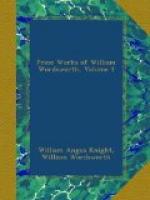I conclude with regret, because I have not said one half of [what I intended] to say; but I am sure you will deem my excuse sufficient, [when I] inform you that my head aches violently, and I am in other respects unwell. I must, however, again give you my warmest thanks for your kind letter. I shall be happy to hear from you again: and do not think it unreasonable that I should request a letter from you, when I feel that the answer which I may make to it will not perhaps be above three or four lines. This I mention to you with frankness, and you will not take it ill after what I have before said of my remissness in writing letters.
I am, dear Sir,
With great respect,
Yours sincerely,
W. WORDSWORTH.[46]
[46] Memoirs, vol. i. pp. 192—200.
IV. DESCRIPTIVE.
(a) A GUIDE THROUGH THE DISTRICT OF THE LAKES.
(b) LETTERS, &c, ON KENDAL AND WINDERMERE RAILWAY.
NOTE.
See Preface in Vol. I. for details on the ‘Guide’ and these Letters. G.
A =GUIDE= THROUGH THE =DISTRICT OF THE LAKES= IN The
North of England.
WITH =A DESCRIPTION OF THE SCENERY, &c.= FOR THE USE
OF =TOURISTS AND
RESIDENTS=.
* * * * *
=FIFTH EDITION=, WITH CONSIDERABLE ADDITIONS.
* * * * *
=BY WILLIAM WORDSWORTH=.
KENDAL:
PUBLISHED BY HUDSON AND NICHOLSON,
AND IN LONDON BY
LONGMAN & CO., MOXON, AND WHITTAKER & CO.
1835.
CONTENTS.
* * * * *
DIRECTIONS AND INFORMATION FOR THE TOURIST.
Windermere.—Ambleside.—Coniston.—Ulpha
Kirk.—Road from Ambleside to
Keswick.—Grasmere.—The Vale
of Keswick.—Buttermere and
Crummock.—Lowes-water.—Wastdale.—Ullswater,
with its tributary
Streams.—Haweswater, &c.
DESCRIPTION OF THE SCENERY OF THE LAKES.
SECTION FIRST.
VIEW OR THE COUNTRY AS FORMED BY NATURE.
Vales diverging from a common Centre.—Effect
of Light and Shadow as dependant upon the Position
of the Vales.—Mountains,—their
Substance,—Surfaces,—and Colours.—Winter
Colouring.—The Vales,—Lakes,—&sh
y;Islands,—Tarns,—Woods,—Rivers,—Climate,—Night....
p. 235
SECTION SECOND.
ASPECT OF THE COUNTRY AS AFFECTED BY ITS INHABITANTS.
Retrospect.—Primitive Aspect.—Roman and British Antiquities.—Feudal Tenantry,—their Habitations and Enclosures—Tenantry reduced in Number by the Union of the Two Crowns.—State of Society after that Event.—Cottages,—Bridges,—Places of Worship,—Parks and Mansions.—General Picture of Society.... 256
SECTION THIRD.




